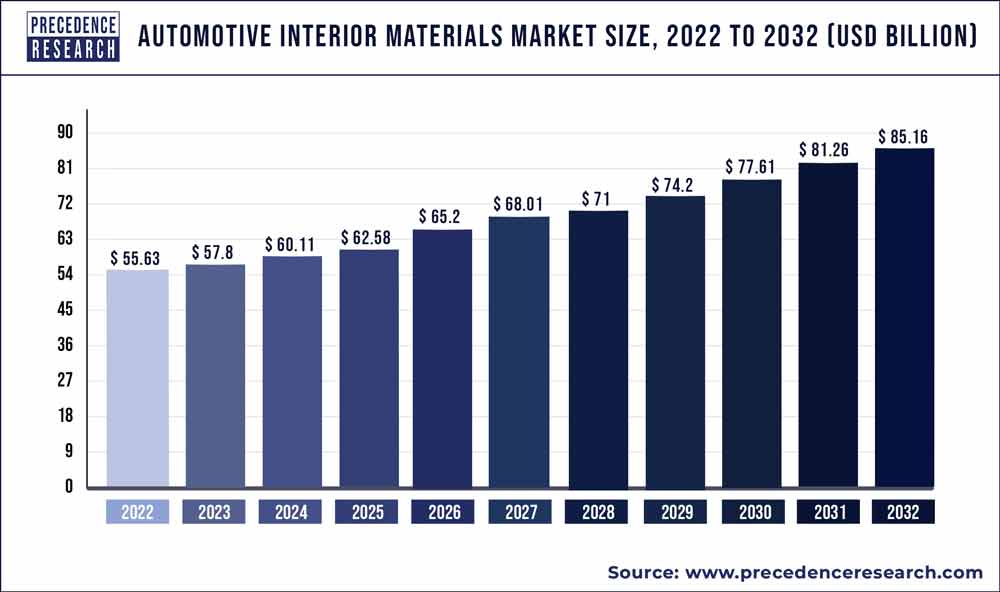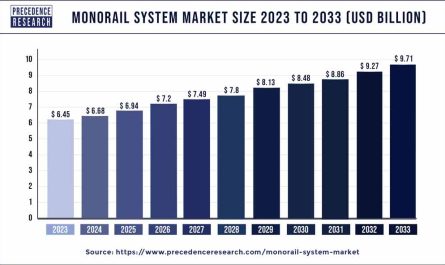The automotive interior materials market size is poised to grow by $ 85.16 billion by 2032 from $ 55.63 billion in 2022, exhibiting a CAGR of 4.4% during the forecast period 2023 to 2032.

The interior materials used in automobiles play a crucial role in their overall design. These materials, such as plastics, composites, metals, and others, are employed to create the cabin environment of a vehicle. With the growing demand for high-performance vehicles, there is also an increasing need for improved ergonomics and attractive aesthetics in automotive interiors. Consumers nowadays expect advanced lighting options and a higher level of comfort in their vehicles, which are now standard features in almost every new automobile.
Automotive interior materials find application in various parts of the vehicle, including doors, console, seats, dashboards, floor carpets, steering wheels, and other interior components. Manufacturers strive to meet these demands to enhance the overall driving experience and meet the evolving preferences of modern car buyers.
Growth Drivers in the Automotive Interior Materials Market
The automotive industry is experiencing a surge in demand for lightweight vehicles and their associated components. This trend extends to the body parts and materials used in the manufacturing process, making automotive interior materials a focal point for growth in the coming years. The cabin section of an automobile plays a crucial role in determining the overall weight of the vehicle, making the development of lightweight automotive interior materials essential for emission reduction.
In recent times, there has been a significant increase in the demand for low-emission materials, especially from emerging nations. Additionally, the automotive industry is experiencing substantial growth in the market for interior materials due to stringent fuel economy standards. Notably, in 2018, China’s Ministry of Industry and Information Technology (MIIT) introduced new guidelines mandating passenger vehicles to meet an average fuel economy of 5.8 liters per 100 kilometers. China has outperformed the USA, Europe, Japan, Australia, and other regions in terms of average fuel efficiency for new cars over the last decade.
Despite these positive developments, there are challenges to consider. One such challenge is the escalating prices of natural leather, which could impede the market’s growth. Consequently, the demand for synthetic leathers is expected to rise as a viable alternative. The scarcity of natural leather and the growing demand-supply gap, coupled with stricter regulations on the use of synthetic materials due to their non-biodegradable nature, have prompted governments in various regions to promote the application of natural leather across industries. These factors are projected to drive the growth of the automotive interior materials market in the foreseeable future.
Report Highlights:
The Asia Pacific region is at the forefront of the global automotive interior materials market, mainly due to the remarkable growth of the automotive industry in this area.
North America and Europe also hold significant shares in the global automotive interior materials market, primarily because of the stringent regulations and amendments related to automotive applications in these regions.
Among the different materials, plastics accounted for the largest share of revenue in 2020. This can be attributed to its favorable characteristics, such as reducing vehicle weight and enhancing aesthetics.
Seats emerged as the dominant application segment in the global automotive interior materials market, accounting for nearly 30% of the market in 2020. The focus on driver and passenger comfort has driven this segment’s importance
Passenger cars led the global automotive interior materials market in 2020 and are projected to maintain this trend over the forecast period. The high sales rate of passenger cars compared to other vehicle types contributes to this dominance.
The aftermarket segment captured a considerable share of revenue and is expected to witness rapid growth during the forecast period. This surge is primarily due to the increasing demand for parts replacement in vehicles.
Regional Overview
In terms of geography, the Asia Pacific region takes the lead in the global automotive interior materials market and is expected to maintain this trend in the foreseeable future. It is projected that the region will account for nearly 50% of the total revenue share during the analysis period. The driving force behind this dominance is the increasing sales of automobiles in the Asia Pacific region. Factors such as rapid urbanization, robust economic development, and the growing purchasing power of the middle-class population further contribute to the significant growth of the automotive interior materials market in this region.
Key Players & Market Strategies
The global automotive interior materials market is expected to witness fierce competition in the coming years, primarily due to the increasing emphasis on research and development by key players. These market participants are employing aggressive strategies to retain their competitive advantage on a global scale. Additionally, inorganic growth strategies, including product development, mergers and acquisitions, partnerships, and collaborations, are also being adopted by industry players.
Some of the key players in the global automotive interior materials market are Evonik Industries AG, UFP Technologies, Saudi Basic Industries Corporation (SABIC), Arkema, BASF SE, Stahl Holdings B.V., Hexcel Corporation, Continental AG, Toray Industries Inc., Huntsman International, Sumitomo Chemical Company, Dow Chemical Company, Trinseo S.A., Borealis AG, and Covestro AG among others.
Segments Covered in the Report
By Material Outlook
- Composites
- Glass Fiber
- Carbon Fiber
- Natural Fiber
- Plastics
- Thermosets
- Thermoplastics
- Leather
- Fabrics
- Others
By Vehicle Outlook
- Passenger Cars
- Light Commercial Vehicle (LCV)
- Heavy Commercial Vehicle (HCV)
By Application Outlook
- Doors
- Consoles & Dashboards
- Seats
- Floor Carpet
- Steering Wheels
- Others
By End-users Outlook
- OEMs
- Aftermarket
By Regional Outlook
North America
- U.S.
- Canada
Europe
- U.K.
- Germany
- France
Asia Pacific
- China
- India
- Japan
- South Korea
Rest of the World
You can place an order or ask any questions, please feel free to contact at sales@precedenceresearch.com | +1 9197 992 333

